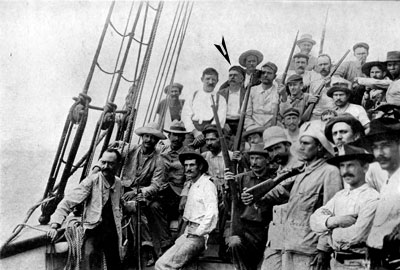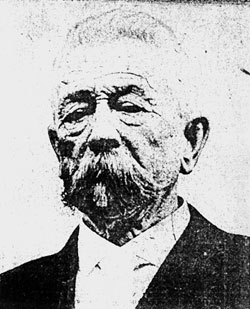|

Captain 'Dynamite Johnny' O'Brien and
his filibustering outlaws bound for Cuba.
The arrow indicates Captain O'Brien.
(Paine, Ralph D., Bright Roads of Adventure, New
York: Houghton Mifflin, 1922) |
As is
known, one of the reasons for the failure of Cuba’s Ten
Years’ War against the Spanish colonial power (1868-1878)
was the small number of expeditions to land on the Cuban
coast with military supplies for the Liberation Army. The
Cuban revolutionary leadership in exile was aware of this,
and from 24 February 1895, the date on which the
independence struggle broke out for a second time, it
assigned priority to the task of importing supplies for
the revolutionary forces. Efforts were concentrated in the
United States and came mainly from among the tobacco
workers, though other elements of the Cuban émigre
population were involved to a lesser extent. To make the
enterprise more effective, an Expeditionary Department was
created, with a constitution approved on 2 August 1896.
Colonel Emilio Núñez was placed at its head.
Among the
ranks under his command, special importance was attached
to those who were to command ships, since they would be
responsible for their vessels’ safe passage - not just in
the face of harsh sea conditions, but also if confronted
by United States and Spanish gunboats.
Foremost
in these duties for his skill and daring was a captain of
Irish origin, John "Dynamite" O’Brien. Recruited by John
D. Hart, he joined the Cuban struggle in early 1896. As
owner of the steamer
Bermuda
he was able to use the ship for transporting supplies to
the independence forces. He had accepted the contract
‘more out of sympathy with the Cuban cause than for the
small amount of money that was offered’. Nevertheless, he
took his duties so seriously that he replaced the entire
crew and ‘not even to his own family did he confide his
commitment or whereabouts’ (García del Pino 1996:46). In
order to put the United States authorities off track,
supplies were shipped in boxes labelled as medicine or
codfish. O'Brien had already been accused of filibustering
and sent for trial. Yet undaunted and in spite of constant
surveillance by the United States police, he decided to
undertake the difficult task of bringing to Cuba Major
General Calixto García, one of the leaders of the Cuban
Revolution.
The
researcher Gerardo Castellanos has described the dangers
of the crossing:
On Sunday Captain O’Brien on the 'Bermuda'
calmly set out through the narrow bay, bound for Veracruz.
He was soon surrounded by a number of tugs bearing customs
officers and newspapermen, all hopeful of taking the
expeditionary force by surprise. These were disappointed
however, as the cargo had been carefully hidden. At Sandy
Hook the curious were dispersed by a snowstorm. O’Brien
took the opportunity to head east, and only when he was so
far out from land that not even the smoke from his funnel
could be seen did he take his true course south, heading
towards Atlantic City. The rest of the expedition had been
assembled in that city, to leave from there on Monday
morning, the sixteenth. […] These took to a fishing boat
in Great Egg Harbour and unfurled the agreed sign, a white
flag. The transfer was carried out so speedily that it
went unnoticed by anyone in the vicinity, and when the
police’s suspicions were aroused the
Bermuda
had already been at sea for four days (Castellanos
García 1927: 166).
During the
voyage, the Irish captain made good use of his
navigational skills, bringing the expedition to a safe
conclusion by landing on 24 March 1896 near the city of
Baracoa, in the extreme east of the island of Cuba. The
shipment consisted of 3,000 rifles, a million rounds of
ammunition, two artillery pieces, a printing press,
revolvers, medicine and food. A few months later these
supplies were to enable Major General Calixto García to
mount an offensive in Cuba’s eastern province.
Francesco
D. Pagliuchi, an Italian crew member, described the scene
as they made land:
The
dark ship […] was surrounded by a flotilla of small boats,
moving rapidly like an army of ants. Each one bore away
its arms and returned to get more. A subtle breeze from
the coast wafted tropical fragrances towards us. In a few
hours the men had finished their work. We would have loved
to shout 'Viva
Cuba Libre!'
at the top of our voices, but we were only a couple of
miles from the port of Baracoa. We contained our
enthusiasm and left as silently as we had arrived (Pertierra
Serra 2000:80).
By June,
O'Brien was captain of the steamer Comodoro, and
had signed on for another expedition. This time he brought
to Cuba 400 rifles, 500,000 rounds of ammunition, 300
machetes, 2,500 pounds of dynamite, an electric battery,
5,000 feet of wire cable, together with medicine, surgical
and other equipment (García del Pino 1996: 55). Again in
August the tireless Irish seaman set out for Cuba.
Commandeering the Dauntless he landed on the coast
of Camagüey 1,300 rifles, 100 revolvers, 1,000 machetes,
800 pounds of dynamite, 46,000 rounds of ammunition, an
artillery piece, a half tonne of medical supplies and
several hundred saddles (García del Pino 1996:60).
|

Dynamite Johnny O'Brien dies at 80,
obituary.
(The New York Times, 22 June 1917, p. 12). |
O'Brien
was to undertake another voyage to Cuba in March 1897. He
set out from Cayo Verde, at the southern tip of the
Bahamas, as captain of the steamer Laurada. A
number of distinguished crewmen were on board: generals
Joaquín Castillo Duany and Carlos Roloff; José Martí Zayaz
Bazán, son of José Mártí, Cuba’s national hero, together
with the internationalist Alphonse Migaux, a veteran of
the Franco-Prussian War who had made his military skills
available to the Cubans. On this occasion, too, the
supplies transported were substantial: 2,050 rifles,
1,012,000 rounds of ammunition, two artillery pieces,
3,000 artillery rounds, 3,000 pounds of dynamite, 750
machetes, a machine-gun, torpedoes, clothing and other
materials. The shipment was used in the assault and
capture of the city of Las Tunas under the command of
Lieutenant General Calixto García. This event contributed
greatly to the resignation of the infamous Valeriano
Weyler, the infamous head of the Spanish government on the
island.
“Dynamite”
almost lost his life in one of those perilous voyages. He
left for Cuba on 22 January 1898 aboard the steamer
Tillie, a small, dilapidated vessel. Forty-seven miles
out from the United States coast, she began to founder.
The crew took to the boats. Pagliuchi described the
fateful moments:
On my
boat were Captain O’Brien, the captain of the ship,
several sailors and a few Cuban volunteers - fourteen in
all. After we had moved away from the ship the captain,
upon seeing that she was not sinking as fast as expected,
urged us to try to save her […] Once the boat was
salvaged, O’Brien ordered us […] to push her forward. We
rowed for five endless hours in the face of fifteen-metre
high waves, until we saw the largest sailing ship then
afloat: the 'Governor T. Eames', a fine ship […] she was
coming to rescue us. Finally, the 'Tillie' was swallowed
up by the waters (Pertierra Serra 2000: 91).
But
nothing would stop the intrepid Irishman. He resumed his
freedom-fighting adventures on 14 February 1898. At the
helm of the Dauntless, he arrived uneventfully to
the coast of Camagüey. On this occasion the expeditionary
force was composed of 24 men, among them general Eugenio
Sánchez Agramonte. Yet again the revolution was furnished
with large quantities of war material, thanks to
“Dynamite” and his decision to serve the Cuban
revolutionary cause.
Once the
1895 campaign was over O’Brien piloted the steamer
Wanderer to Pinar del Río, in the west of Cuba.
Mission accomplished, he returned to Key West. However,
shortly before the conflict ended, O’Brien was one of the
protagonists of the epic of the ship Three Friends.
Let us return to the testimony of Pagliuchi, who
accompanied O’Brien on that voyage and left an account
worthy of a movie script: |


